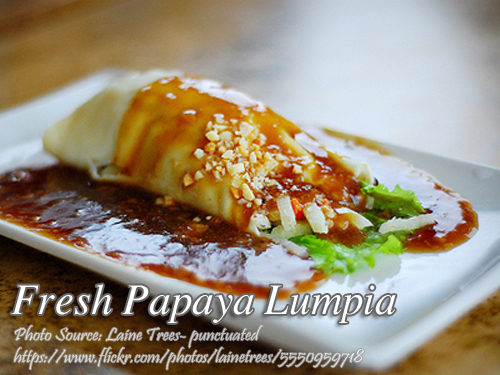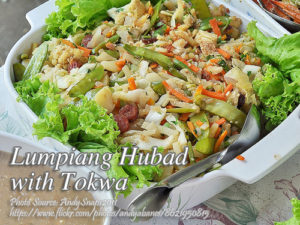This fresh lumpia or lumpiang sariwa recipe is one of the favorite among Filipino dishes and there are variations of fresh lumpia. One of those is the lumpiang ubod which is the most favorite but some just use mung bean sprouts. Ubod or heart of palm is not readily available in most wet markets or supermarkets so if you are thinking of any substitutes, why not try green papaya? I’m sure you will love this Lumpiang papaya. I posted this vegetable recipe today for those who wants to abstain from meat because it’s Good Friday today. But there is a teeny-weeny minced pork and shrimps added and I think it won’t hurt.
Lumpiang Papaya: A Fresh Take on a Filipino Classic
Whenever I visit my Tita Cora’s home in Batangas, there’s one dish that always takes center stage at the dining table—lumpiang sariwa. She would carefully prepare each roll, her hands skillfully wrapping the filling in soft, tender lumpia wrappers. Her favorite variation is lumpiang papaya, and for good reason. It’s a simple, economical dish that brings together the earthy flavors of green papaya and a medley of vegetables in a light, savory sauce.
I remember the first time I tasted it as a child, sitting by the kitchen window while she cooked. The scent of garlic and onions sizzling in annatto-infused oil filled the air, making my mouth water. Since then, I’ve carried that memory into my own kitchen, tweaking the recipe slightly to suit my family’s tastes.
A Nostalgic Alternative to Lumpiang Ubod
Lumpiang ubod, made with the heart of palm, is undeniably one of the most beloved fresh lumpia recipes in the Philippines. However, finding fresh ubod can sometimes feel like a treasure hunt in wet markets or supermarkets. That’s where green papaya comes in—it’s readily available, affordable, and a perfect substitute.
My cousin Tito Jun, a farmer in Laguna, once told me that papaya isn’t just for tinola or achara. He suggested trying it as a filling for lumpia, and I haven’t looked back since. Its subtle sweetness and tender-crisp texture pair wonderfully with the mung bean sprouts, cabbage, and celery.
The Secret to Perfect Lumpiang Papaya
The secret to achieving flavorful lumpiang papaya lies in layering the ingredients and techniques. It starts with making annatto water, which gives the filling a warm, golden hue and enhances its visual appeal. Sauteing garlic and onions in this infused oil creates a savory base that ties all the flavors together.
Adding a small amount of minced pork and shrimp gives the filling a savory depth, but it’s entirely optional if you’re keeping the dish vegetarian. The pork fat and shrimp juices mingle with the annatto oil, creating a rich flavor that clings to the shredded papaya and other vegetables.
Simmering the mixture ensures the vegetables stay tender but not soggy. Letting the filling cool before wrapping it in the lumpia wrapper is crucial—it keeps the wrapper from tearing and makes rolling much easier.
Wrapping the Lumpia: A Step-by-Step Experience
I’ve always enjoyed the hands-on process of making lumpiang papaya. Laying out the fresh lettuce or cabbage leaf on the wrapper feels like preparing a little gift for the person who will eat it. Tita Cora taught me to spread the filling evenly, fold in the edges, and roll it tightly into a neat cylinder.
When my sister Carla came home from Cebu last summer, she joined me in making this dish for our family reunion. We laughed as we tried to outdo each other in making the most perfectly wrapped lumpia. It reminded me how food, especially Filipino food, has a way of bringing people together.
The Essential Lumpia Sauce
Of course, no lumpiang papaya is complete without its signature sauce. The lumpia sauce—a combination of soy sauce, brown sugar, flour, and cornstarch—is simple but transformative. Stirring the mixture over medium heat until it thickens is an almost meditative process, and the result is a glossy, sweet-savory topping that ties everything together.
When I serve this dish, I always sprinkle a bit of minced garlic over the sauce for that extra layer of flavor. My Lolo Ramon used to insist that the garlic was the best part—it adds a pop of sharpness that contrasts beautifully with the sweet sauce and earthy vegetables.
Food for Thought: The History of Lumpia
Lumpia has its roots in Chinese cuisine, brought to the Philippines centuries ago by traders. Over time, it has evolved to reflect local flavors and ingredients. From fried lumpia to fresh lumpiang sariwa, this versatile dish has found its way into almost every Filipino household.
Using green papaya as the star ingredient is just one example of how resourceful Filipino cooks are. It’s a creative twist that reflects the ingenuity of home cooks who adapt recipes to suit their family’s needs and the ingredients available to them.
Why You’ll Love Lumpiang Papaya
Lumpiang papaya is more than just a dish; it’s a testament to the richness of Filipino culinary traditions. It’s perfect for those abstaining from meat or simply looking for a lighter, healthier meal. The fresh vegetables, paired with the tangy, slightly sweet sauce, make for a satisfying and guilt-free treat.
Whether you’re making this for Good Friday, like I did when I first experimented with it, or as a centerpiece for your family gatherings, lumpiang papaya is sure to win hearts. It’s a dish that’s steeped in nostalgia yet offers room for creativity—a true Filipino classic with a twist.
So, gather your ingredients, and give this recipe a try. Who knows? It might just become a family favorite, as it has in mine.
How to Make Lumpiang Papaya
Ingredients
For the Lumpia:
- 1 pc medium sized green papaya peeled and shredded
- 50 grams mung bean sprouts or toge
- 1/2 head cabbage sliced
- 50 grams cooked garbanzos or chickpeas
- 150 grams minced pork
- 1/4 kilo small shrimps peeled and beheaded
- 2 to 3 cloves garlic
- 1 piece onion sliced
- 200 grams annatto atsuete seeds
- 2 stalks celery. minced
- 2 pieces tokwa or tofu cubed
- salt and pepper to taste
- lettuce or sliced cabbage
- minced garlic for garnishing
- 3 Tbsp. cooking oil
For the Lumpia Sauce:
- 1/2 cup all-purpose flour
- 1/2 cup cornstarch
- 1 to 2 Tbsp. soy sauce
- 1 cup brown sugar
- 2 cups water
Instructions
How to make Fresh Papaya Lumpia:
- Pour hot water, about 1/2 cup on the annatto seeds for a few minutes. Strain and reserve the liquid.
- Saute garlic and onion in oil over medium heat. Add pork and shrimps. Then add the annatto water.
- Bring to a boil then add shredded green papaya, mung bean sprouts, celery and sliced cabbage. Simmer until cooked.
- Season with salt and pepper then set aside and let cool.
- Before wrapping the filling, make the lumpia sauce. (see recipe below)
- When ready to serve, add the garbanzos and tokwa to the lumpia filling.
- Place one lumpia wrapper on a plate then put lettuce or sliced cabbage on the wrapper.
- Spread a spoonful of the lumpia filling on top of the lettuce, then fold the lumpia wrapper and roll to form a cylinder.
- Place the fresh lumpia on a plate and pour lumpia sauce over it then sprinkle with minced garlic.
How to make Lumpia Sauce:
- Mix together flour, cornstarch, soy sauce, brown sugar and water. Stir well.
- Place mixture in a saucepan and simmer over medium heat.
- Stir the sauce until you get the desired consistency.
- When done, transfer to a bowl.
Notes
Cooking Tips:
Use Fresh Green Papaya for the Best Texture
Fresh green papaya is key to achieving the right texture for your lumpiang papaya filling. Make sure to peel and shred it finely to ensure it cooks evenly and absorbs the flavors of the sautéed pork, shrimp, and annatto-infused oil. Avoid overcooking the papaya—it should remain tender-crisp to maintain the dish’s signature light and fresh bite.Let the Filling Cool Before Wrapping
Cooling the filling completely before wrapping it in lumpia wrappers prevents the wrappers from becoming soggy or tearing. Hot filling can also steam the wrapper, making it too delicate to handle. This step ensures your rolls are neat, sturdy, and ready to hold up to the rich sauce poured over them.Simmer the Sauce to the Right Consistency
For a silky lumpia sauce, stir the mixture constantly while simmering to avoid lumps and achieve an even consistency. Keep the heat medium to low to prevent the sugar from burning and the sauce from thickening too quickly. The result should be a glossy sauce that drapes beautifully over the lumpia rolls, enhancing both flavor and presentation.






I’d like to try this but not sure if you meant fresh lumpia wrapper instead of the frozen one sold in asian markets.
Hi Malou,
Yes it is the same thing.
Salamat po :-).